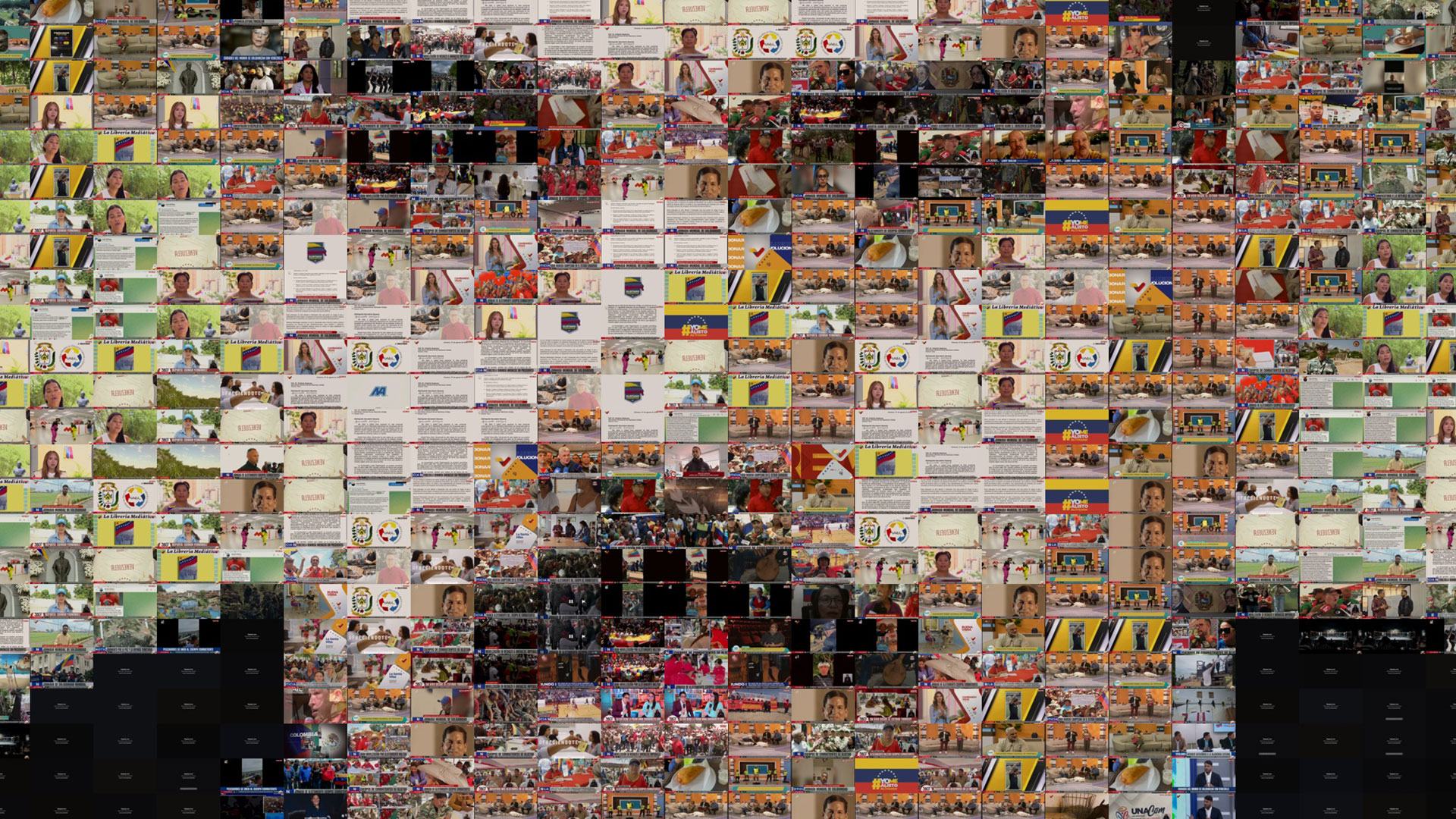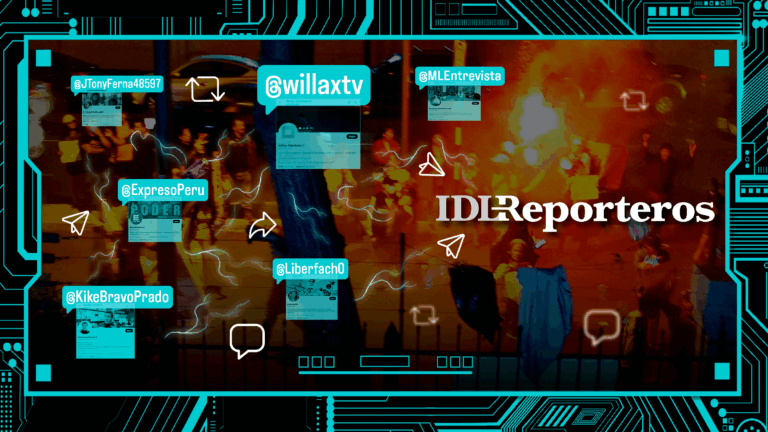An analysis of Venezolana de Televisión’s coverage of the enlistment days for the Bolivarian Militia identified a pattern of slogans, spokespeople, and framing that presented a coordinated campaign as if it were an expression of “the people.”
A press conference called on Monday, September 1, 2025, in a Caracas hotel brought together dozens of national and international correspondents, attentive to the balance of the enlistment days for the Bolivarian Militia that had taken place over the previous two weekends. At the event, Nicolás Maduro laid out arguments in response to the military threat that, for several weeks, the United States had begun to pose to his administration.
“There is a national consensus to enlist to defend the homeland. An 80-year-old woman went there: ‘I’m a nurse, I’m ready,’ welcome (…); workers from all the companies in the country, peasants, women and men, fishers,” Maduro said, stressing that, during the campaign, a total of 8.2 million Venezuelans had enlisted as militia members and reservists.
Maduro presented the mobilization as supposed evidence of the popular backing he enjoys, capitalizing on the images and videos that, in the preceding days, had been repeated nonstop across traditional media outlets and social networks.
The coverage by Venezolana de Televisión (VTV), the main propaganda mouthpiece of his administration — and whose president is the minister of Communication and Information, Freddy Ñáñez — consolidated over several days the image of an apparent nationwide enthusiasm during the enlistment cycle. People walking in and out of frame, live hits from the interior, organizations abroad expressing support, and voices with no apparent party affiliation backing Maduro and calling on others to join the militia.
For this analysis, VTV’s broadcast of the campaign during the second enlistment weekend for the Bolivarian Militia was taken as a basis in order to identify the most frequently repeated narratives that were activated on the channel during those days, some of which have remained present in official discourse ever since. Based on these repetition patterns and the variations in the slogans being delivered — with coordinated hand-offs between studio and street — it was possible to show how the channel constructed the appearance of a “spontaneous” consensus backing the enlistment days during its broadcast, despite traces that suggest careful coordination rather than spontaneity.
The “people” selected by VTV to speak
La Hora de Venezuela analyzed 30 hours of VTV broadcasts between August 28 and 29, 2025 (excluding the early-morning hours) and carried out semantic tallies of key narratives that were repeated during that second weekend of the Bolivarian Militia enlistment campaign.
To determine the narratives that would be tracked in the broadcast, a preliminary list was drawn up with 10 recurring phrases — and their variations — detected between August 23 and October 1, based on continuous monitoring of public discourse. That inventory established guiding phrases that appeared, in some cases, during VTV’s coverage. For the analysis, AI-generated transcripts of recordings of the coverage on both days were used; the guiding phrases were tracked using natural-language-processing techniques and then checked manually.
The campaign, which was called “Venezuela is not a threat, it is hope,” was pushed both in traditional media and on social networks. That phrase — in English — was first used by Maduro in March 2015, in response to Barack Obama’s Executive Order 13692, which declared the situation in Venezuela an “unusual and extraordinary threat.”
During the campaign promoted in August 2025, other slogans were repeated with subtle variations that reveal the coordination of multiple actors. For example, the narrative “the peoples of the world reject imperial aggression” was constantly repeated by government spokespeople, anchors, and reporters on the channel in several news blocks and live street hits.
The slogan, reiterated constantly on VTV, is intended to display a generalized rejection of any foreign intervention, even though the only shots shown on screen and testimonies aired were those reinforcing the slogan, coming mostly from militants, sympathizers, and aligned spokespeople, while dissent was kept off camera. In an information ecosystem like Venezuela’s, marked by censorship and few options for free-to-air TV, that selection is designed so that, in the absence of dissenting voices, it seems as if everyone agrees.
Another overarching slogan identified is “the Venezuelan people defend sovereignty and peace,” which was repeated — with its respective variations — 471 times over the 30 hours of programming analyzed.
During the campaign, the term “people” was used in a homogeneous way and in favor of the government and, in the same vein, “peace” and “sovereignty” were used, almost interchangeably, as euphemisms to signal loyalty and support for Maduro’s administration. VTV’s coverage of the enlistment days repeatedly showcased “peace” messages that softened their military nature, while presenting the United States as the sole aggressor.
In a context like Venezuela’s, where laws and controls encourage self-censorship and there is systematic persecution of dissent, especially on issues of national security, the sustained repetition of these slogans on VTV and the absence of other points of view tend to project them as a majority opinion among Venezuelans — as a show of support “without a political agenda” — even though the coverage is carried out by a channel under the full control of the ruling party.
Protecting the neighborhood as a self-defense argument
Alongside narratives aimed at projecting internal unity, other lines detected in VTV’s coverage scaled the framing up to a more regional level: from presenting an alleged continent-wide backing of the Bolivarian government to the idea of a domestic consensus about the risk that any U.S. action in Venezuela would pose for neighboring countries.
These lines were repeated, with different variations, in slogans such as: “Venezuela is not a threat and is not alone,” detected 128 times; “the militarization of the Caribbean threatens the peoples,” detected 18 times; and “intervention in or threats against Venezuela are a prelude to an attack on Latin America and the Caribbean,” detected an additional 18 times.
In practice, these narratives seek to shift the focus away from domestic allegations and toward a shared continental cause, attempting to symbolically raise the political cost for other countries of supporting the United States, while reinforcing the idea that, instead, Venezuela is unanimously backed by its neighbors.
Other ideas conveyed during the coverage were reactions to accusations made by the United States about drug transit or trafficking linked to Venezuela, though framed with propagandistic and disinformative language.
For example, a misleading claim was repeated, citing a report by the United Nations Office on Drugs and Crime (UNODC), according to which the UN had “confirmed” that Venezuela is neither a country of origin nor a transit country for cocaine. The report, however, contains no such conclusion and, instead, includes maps that show Venezuela as a transit territory, although without specifying the amounts of drugs coming from Colombia that would circulate through the country.
The phrase “The U.S. is the world’s largest consumer of drugs” — with various formulations — was also detected 13 times, emphasizing its alleged hypocrisy in the fight against narcotics. The argument sidesteps the accusations about drug-trafficking networks in Venezuela and redirects them toward the accuser itself, a clear example of the “whataboutism” technique regularly used in Venezuelan propaganda.
During the campaign, high-level spokespeople (such as Vice President Delcy Rodríguez) recycled the same angle in a public address that was also broadcast on VTV.
Public television as a megaphone for a coordinated campaign
VTV is a state-owned channel whose editorial line is defined directly by the Ministry of Popular Power for Communication and Information (Ministerio del Poder Popular para la Comunicación e Información, Mippci) and is one of the main public outlets attached to the Bolivarian System of Communication and Information (Sistema Bolivariano de Comunicación e Información, SiBCI). The asymmetry of resources and the scarcity of alternative TV options leave those who might wish to inform the public without a propagandistic agenda on Venezuelan broadcast television without equivalent counterweights.
But the channel is only one piece in a much larger media apparatus used to amplify Venezuelan government propaganda, disinformation cases, rumors, or campaigns that validate each of the talking points set by the Maduro leadership.
This strategy is explicitly spelled out in a manual, the official method “Streets, networks, media, walls, and word of mouth” («Calles, redes medios, paredes y radio bemba«) — signed by Nicolás Maduro — which proposes responding to a supposed “cognitive war” against his government by aligning spokespeople, content, and schedules, leveraging public resources, coordination, and the repetition of slogans on multiple platforms, while obscuring dissenting voices that, in many cases, are also persecuted or censored.
In that sense, the international campaign “Venezuela is not a threat, it is hope” is not very different from other similar ones promoted by the same government-run information operation. For that reason, multiple campaigns, with distinct lines of discourse and specific content, are always amplified through the same propaganda ecosystem.
The coverage of the enlistment drive is a case study of this scheme: yet another campaign in which the coordinated support of the same loyal militant base is presented as if it were the spontaneous support of the entire Venezuelan “people.”
Journalism in Venezuela is practiced in a hostile environment for the press, with dozens of legal instruments ready to punish speech, especially the laws “against hatred,” “against fascism,” and “against the blockade.” This content was written taking into account the threats and constraints that, as a consequence, have been imposed on the publication of information from inside the country.
Cazadores de Fake News investiga a detalle cada caso, mediante la búsqueda y el hallazgo de evidencias forenses digitales en fuentes abiertas. En algunos casos, se usan datos no disponibles en fuentes abiertas con el objetivo de reorientar las investigaciones o recolectar más evidencias.




